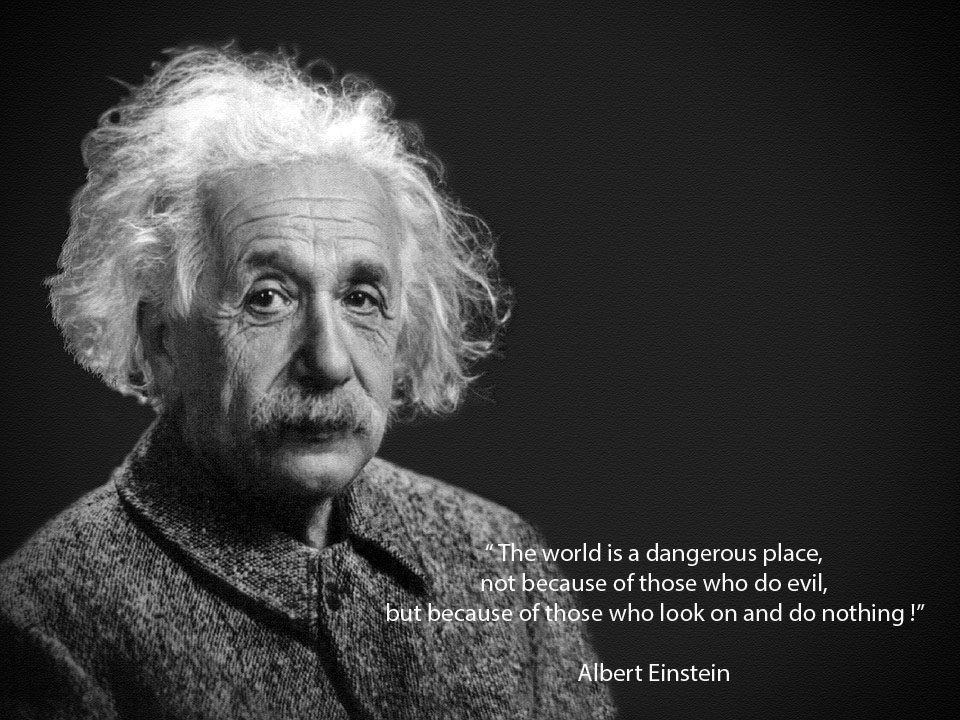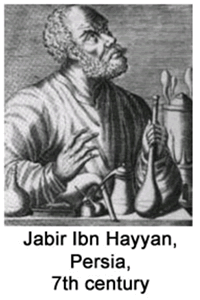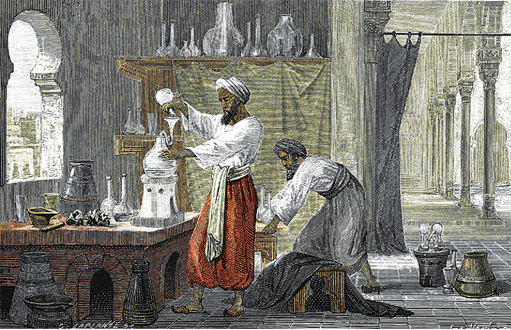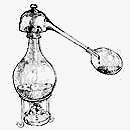

Latinized name Geber , the father of Alchemistry.
"His influence may be traced throughout the whole historic course of European alchemy and chemistry."
Max Meyerhoff
A brief note about AlKemie to Chemistry
- Alchemy was born in ancient Egypt. The word Khem was used in reference to the fertility of the flood plains around the Nile River. Based on the “life after death” belief, the mummification procedures, which were accompanied by the use of a variety of mixed compounds, probably were the basic foundation of knowledge for chemical concepts.
- By 332 BC, Alexander the Great had conquered Egypt. Greek philosophers’ views for the concept of matters were merged with Egyptian sacred science. The result was Khemia, the Greek word for Egypt, meaning 'the Black Land '.
- Alchemy was also developed independently in China by Taoist monks. The monks pursued both the outer elixir and the inner elixir. The former being minerals, plants, and other, which could prolong life; and the latter, being the use of exercise techniques, such as Qigong, to manipulate the chi or life force of the body. Like China and Egypt, India developed alchemy independently as well. They had beliefs similar to the Chinese, in that they used external and internal methods to purify the body and prolong life. In their work, the Indians invented steel, and long before Bunsen and Kirchhoff's work, they realized the importance of flame colors in the identification of metals.
- When Egypt was occupied by the Arabs in the 7th Century, they added 'al-' to the word Khemi; where again al-Khemia meant 'the Black Land '.
- Persia was also occupied by the Arabs (in 641). The Persian Alchemist had to present his work in the Arabic language. There are unmistakable traces of Persian influence, manifested distinctly by linguistic affinities in technical names and usage and in names of minerals. These traces are sufficiently well marked to render it probable that Persia was, indeed, one of the main channels through which alchemy came to Islam; and it is not without interest to note that many of the principal Muslim alchemists were Persians.
Abu-Musa-Jabir-ibn-Hayyan (Latinized name: Geber), born c. 721 in Tus, Khorasan, Iran. He wrote more than one hundred treatises on various subjects, of which 22 are about alchemy. Jabir discovered hydrochloric acid (from salt) and nitric acid (from saltpeter). By combining the two, he invented aqua regia, one of a few substances that can dissolve gold. He discovered 19 elements along with their specific weights. Besides its obvious applications to gold extraction and purification, this discovery would fuel the dreams and despair alchemists for the next thousand years. He is also credited with the discovery of citric acid (the sour principle of lemons and other unripe fruits), acetic acid (from vinegar), and tartaric acid (from wine-making residues).
Zakariya al-Razi (in Latin: Rhazes or Rasis) was born in Rayy, Iran, 864; died in Baghdad, 930 AD. He was a philosopher who made fundamental and lasting contributions to the fields of medicine and alchemy. He is credited with, among other things, the discovery of sulfuric acid, the "work horse" of modern chemistry and chemical engineering; and also of alcohol and its use in medicine; recorded in over 184 books and articles in various fields of science.
Ibn-Sina (979-1037), who is better known as Avicenna, the Latinized corruption of his name, was indeed the most important physician between the time of the Roman Empire and that of the rise of modern science. Ibn Sīnā wrote almost 450 treatises on a wide range of subjects, of which around 240 have survived. In particular, 150 of his surviving treatises concentrate on philosophy and 40 of them concentrate on medicine. Ibn Sīnā is regarded as a father of modern medicine. In chemistry, the chemical process of steam distillation was first described by Ibn Sīnā. The technique was used to produce alcohol and essential oils; the latter was fundamental to aromatherapy. He also invented the refrigerated coil, which condenses the aromatic vapors.
Abu Mansur Muvaffak Harawi was a 10th century Persian physician. Abu Mansur distinguished between sodium carbonate and potassium carbonate, and seems to have had some knowledge about arsenious oxide, cupric oxide, silicic acid, and antimony; he knew the toxilogical effects of copper and lead compounds, the depilatory virtue of quicklime, the composition of plaster of Paris and its surgical use.
Ibn Al-Hassan Ibn Ali Al-Tughra'i'. He was born in Isfahan, Iran in 1061CE. In the field of alchemy, al-Tughra'i is best known for his large compendium titled "Mafatih al-rahmah wa-masabih al-hikmah", which incorporated extensive extracts from earlier Arabic alchemical writings, as well as Arabic translations from Zosimos of Panoplies old alchemy treatises written in Greek, which until 1995 erroneously were attributed to unknown alchemists by mistake and inconsistencies made in the transliteration and transcription of his name into Arabic. In 1112CE, he also composed "Kitab Haqa'iq al-istishhad", a rebuttal of a refutation of alchemy written by Avicenna.
Little is known in the West about the character and history of Hindu alchemy. An eleventh century Iranian alchemist named al-Biruni reported that they have a science similar to alchemy which is quite peculiar to them. They call it Rasayana. It means art that is restricted to certain operations, drugs, compounds, and medicines, most of which are taken from plants. Along with al-Kindi and Avicenna, al-Biruni was one of the first chemists to reject the theory of the transmutation of metals supported by some alchemists.
The introduction of alchemy to the west came in the 8th Century when the Arabs brought it to Spain. From here it quickly spread to the rest of Europe. The Arabian belief was that metals are made up of mercury and sulfur in varying proportions. Gold was seen as the perfect metal and all others were less perfect, an idea popular among western alchemists. It was a very popular idea indeed, where these lower metals could be transmuted into gold by means of a substance known as the Philosophers Stone.
Eventually, by the 16th Century, the alchemists in Europe focused on the discovery of new compounds and their reactions leading to what is now the science of chemistry.
Robert Boyle (1627 – 1691) was born in Ireland and was a natural philosopher, chemist, physicist, inventor, and gentleman scientist. He is best known for the formulation of Boyle's law. Although his research and personal philosophy clearly has its roots in the alchemical tradition, he is largely regarded today as the first modern chemist, and therefore one of the founders of modern chemistry.
Antoine-Laurent de Lavoisier (1743 –1794) was a French noble prominent in the history of chemistry and biology. He stated the first version of the law of conservation of mass recognized and named oxygen (1778) and hydrogen (1783), abolished the phlogiston theory, helped construct the metric system, wrote the first extensive list of elements, and helped reform chemical nomenclature. He discovered that, although matter may change its form or shape, its mass always remains the same. Thus, for instance, if water is heated to steam, if salt is dissolved in water or if a piece of wood is burned to ashes, the total mass remains unchanged. Overall, his contributions are considered the most important in advancing chemistry to the level reached in physics and mathematics during the 18th century.


